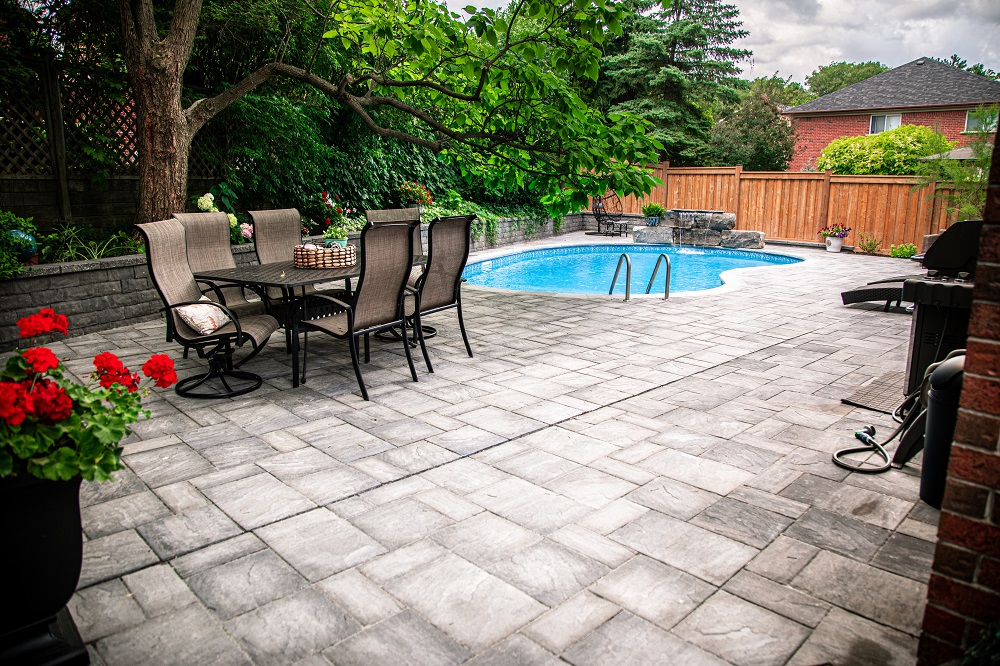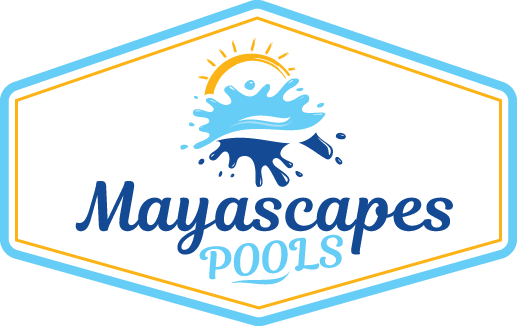Installing an inground swimming pool in your background is more than just digging a hole in the ground and fitting a fiberglass or vinyl pool. You also have to think about the surrounding area around the pool and the landscaping to get that backyard oasis that you’ve always wanted.
Things you need to know when getting pavers installed around your inground pool deck
What to Consider when Installing Pavers Around your Backyard Inground Pool
One of the best ways to enhance your pool area is by installing interlocking or concrete pavers around the swimming pool. Pavers can vastly improve the look of your pool area and make it more functional. As turn-key pool contractors, here are a few things we do when installing pavers around your backyard pool.

Ensuring proper drainage around pool deck
When installing your inground pool, we always make sure you the water is sloping away from the house 1/8” ft and sloping away from the pool. You don’t want water sloping towards the pool as your pool will always need to be cleaned and you will be over working your filter. We typically create a valley in the pavers instead of using metal drains for better aesthetics. Check out this video on how we ensure proper drainage in your back yard.

The line across the interlocking back patio is a valley, placed to move water away from your home and away from the pool. Using a slight slope, water will drain to the valley and get swept away. In this backyard, water is carried to gardens on either side of the patio. The valley is an excellent upgrade from the metal drainage grates typically found in hardscapes around a pool.
Prepare proper trenches for gas line and conduits
At Mayascapes Pools, we make sure your gas line for your heater and your electrical conduits are in separate trenches at least 2’ apart x 18” deep.
Installation of a sump drain
For all of our inground pool builds, we will put a two-foot overdig and a 4′ perforated pipe around the exterior perimeter of the pool. Positioned at the lowest point around the pool, we will put a sump drain to collect and redirect excess groundwater away from the pool structure. This prevents hydrostatic pressure from building up, which can cause the pool to float or crack. Check out this video for more details on the importance of a sump drain.
Use proper sub-base material to prevent settling of pool deck
When backfilling, we use HPB (high performance bedding) or clear gravel to prevent any settling. If you don’t use the right type of gravel, you will have settling within two years.
Run pressure test on all plumbing before installing pavers
We pressure test all plumbing from the equipment pad to make sure you don’t have any leaks. We do this by getting a small compressor and gauge to make sure each line can hold 15 PSI for ten minutes, while ensuring the pressure test itself does not break the seal.
Running conduits for pool lights
Installing conduit around your electrical lines allows you to change lights in the future if you have any issues. We then check make sure your pool lights are in conduit before backfilling and adding pavers around the pool area.
Contact us for a free inground pool estimate
When deciding to get an inground pool for your backyard, it is important to find an experienced pool contractor who focuses on all the details that comes with the pool and pool deck installation. When getting estimates, it is also important to know what are included and not included in your swimming pool build so that you are not caught off-guard after the digging has started. At Mayascapes Pools, we specialize in installing inground swimming pools along with all the landscaping services around the pool area. Contact us if you are thinking about adding an inground pool in your backyard.
